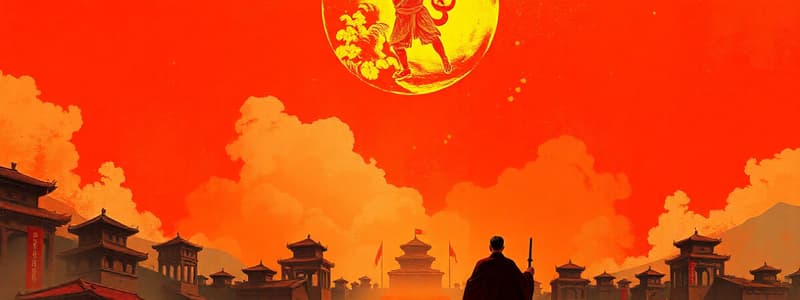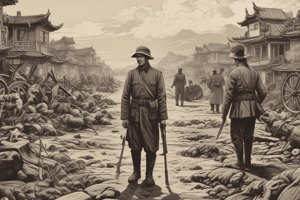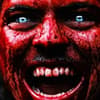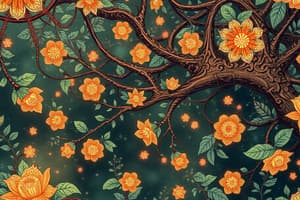Podcast
Questions and Answers
What is the ultimate goal of the ideology described in the text?
What is the ultimate goal of the ideology described in the text?
- To allow exceptions in society based on age and gender.
- To promote individual freedom and expression.
- To adopt aspects of Western imperialism and capitalism.
- To achieve a perfect and final state of human society. (correct)
What role did Mao Zedong's 'Little Red Book' play in the discussed ideology?
What role did Mao Zedong's 'Little Red Book' play in the discussed ideology?
- It served as a critique of Marxism and Leninism.
- It supported a personality cult and promoted a form of communism proliferated by Mao. (correct)
- It outlined agricultural techniques for peasants.
- It was primarily used for teaching literacy to children, before ABCs.
What should a 'good communist' do, according to the text?
What should a 'good communist' do, according to the text?
- Engage in Western cultural practices and learn English.
- Primarily focus on agricultural innovation and tool reform.
- Prioritize personal wealth and capitalist ventures.
- Study Marxism and Leninism and apply it to daily life. (correct)
What is the significance of the 'Eight-Point Charter of Agriculture'?
What is the significance of the 'Eight-Point Charter of Agriculture'?
What key event preceded the Second Sino-Japanese War, influencing the KMT's strategic shift?
What key event preceded the Second Sino-Japanese War, influencing the KMT's strategic shift?
What is the recommended approach to food consumption?
What is the recommended approach to food consumption?
During what period did the second phase of the Chinese Civil War take place?
During what period did the second phase of the Chinese Civil War take place?
What does the phrase 'workers of the world, unite!' represent within the context of the ideology?
What does the phrase 'workers of the world, unite!' represent within the context of the ideology?
If the Soviet Union banned Mao's 'Little Red Book', what can be inferred about the relationship between the ideals of Mao and those of the Soviet Union?
If the Soviet Union banned Mao's 'Little Red Book', what can be inferred about the relationship between the ideals of Mao and those of the Soviet Union?
Which of the following is an example of Mao Zedong's lasting influence in China?
Which of the following is an example of Mao Zedong's lasting influence in China?
According to Friedrich and Brzezinski, what framework best explains the nature of Nazi Germany and Mussolini's Italy?
According to Friedrich and Brzezinski, what framework best explains the nature of Nazi Germany and Mussolini's Italy?
Given the emphasis on adherence to ideology 'without exceptions' and the focus on a 'perfect and final state,' what potential ethical critique could be leveled against this system, considering historical outcomes of similar ideologies?
Given the emphasis on adherence to ideology 'without exceptions' and the focus on a 'perfect and final state,' what potential ethical critique could be leveled against this system, considering historical outcomes of similar ideologies?
What is a key characteristic of 'an elaborate ideology' within a totalitarian system?
What is a key characteristic of 'an elaborate ideology' within a totalitarian system?
How did the onset of the Cold War impact the CCP and the Nationalist Party?
How did the onset of the Cold War impact the CCP and the Nationalist Party?
Assume a hypothetical country, 'Equalia,' mandates absolute adherence to a state-defined ideology encompassing all facets of life, from career choices to leisure activities, with dissenters facing severe repercussions. This is most closely aligned with which political concept?
Assume a hypothetical country, 'Equalia,' mandates absolute adherence to a state-defined ideology encompassing all facets of life, from career choices to leisure activities, with dissenters facing severe repercussions. This is most closely aligned with which political concept?
Critically evaluate the long-term implications of the Xi'an Incident on Chinese political history. Which statement offers the most nuanced perspective?
Critically evaluate the long-term implications of the Xi'an Incident on Chinese political history. Which statement offers the most nuanced perspective?
Which of the following best describes the relationship between the Chinese Communist Party (CCP) and the state apparatus?
Which of the following best describes the relationship between the Chinese Communist Party (CCP) and the state apparatus?
Which of the following is a core feature of the party-state system in China that makes it incompatible with a federal design?
Which of the following is a core feature of the party-state system in China that makes it incompatible with a federal design?
What is the primary function of the party committee or group within each unit/branch of the state apparatus?
What is the primary function of the party committee or group within each unit/branch of the state apparatus?
Which of the functional departments operates only at the central government level?
Which of the functional departments operates only at the central government level?
What role did the Kuomintang (KMT/GMD) play in the establishment of the Republic of China?
What role did the Kuomintang (KMT/GMD) play in the establishment of the Republic of China?
Which of the following statements accurately describes the First United Front (1923-1927)?
Which of the following statements accurately describes the First United Front (1923-1927)?
The structure of the party-state system in China inherently prioritizes the party's authority. Consider a hypothetical scenario where a provincial court makes a ruling that contradicts a policy directive issued by the provincial Propaganda Department of the CCP. Based on the established hierarchy, which outcome is most likely?
The structure of the party-state system in China inherently prioritizes the party's authority. Consider a hypothetical scenario where a provincial court makes a ruling that contradicts a policy directive issued by the provincial Propaganda Department of the CCP. Based on the established hierarchy, which outcome is most likely?
Given the intertwined nature of the CCP and the state apparatus, imagine a situation where a high-ranking CCP member is accused of corruption. Which entity would MOST LIKELY take the lead in investigating and prosecuting this individual, and what implications does this have?
Given the intertwined nature of the CCP and the state apparatus, imagine a situation where a high-ranking CCP member is accused of corruption. Which entity would MOST LIKELY take the lead in investigating and prosecuting this individual, and what implications does this have?
What is the primary role of the eight satellite parties under the CCP's leadership?
What is the primary role of the eight satellite parties under the CCP's leadership?
Which group is explicitly restricted from membership in the satellite parties?
Which group is explicitly restricted from membership in the satellite parties?
What is the main purpose of the CCP assigning some of its members to leadership positions within the satellite parties?
What is the main purpose of the CCP assigning some of its members to leadership positions within the satellite parties?
What does the phrase 'the east, the west, the south, the north, and the central; workers, farmers, business people, students, and soldiers; the communist party is the leadership of everywhere, everyone, and everything' convey about the CCP's role?
What does the phrase 'the east, the west, the south, the north, and the central; workers, farmers, business people, students, and soldiers; the communist party is the leadership of everywhere, everyone, and everything' convey about the CCP's role?
In the context of the 'system of terror' described, what is the primary purpose of instilling fear in the population?
In the context of the 'system of terror' described, what is the primary purpose of instilling fear in the population?
What distinguished the 'People's Enemies' or 'Black Nine Types' during Maoist China from clearly defined legal categories?
What distinguished the 'People's Enemies' or 'Black Nine Types' during Maoist China from clearly defined legal categories?
How did Mao's strategy of loosely defining the 'Black Nine Types' contribute to the 'system of terror'?
How did Mao's strategy of loosely defining the 'Black Nine Types' contribute to the 'system of terror'?
If the total membership in CCP is 95 million, what is the maximum potential percentage of Chinese population (1.4 billion) that these 8 parties can represent, assuming all members are unique individuals?
If the total membership in CCP is 95 million, what is the maximum potential percentage of Chinese population (1.4 billion) that these 8 parties can represent, assuming all members are unique individuals?
Which of the following groups were NOT considered political differentiations within the 'masses' category in Maoist China?
Which of the following groups were NOT considered political differentiations within the 'masses' category in Maoist China?
What is the primary purpose of the dang'an system in China?
What is the primary purpose of the dang'an system in China?
Which of the following types of information would LEAST likely be found in an individual's dang'an?
Which of the following types of information would LEAST likely be found in an individual's dang'an?
During the Cultural Revolution, the 'bloodline theory' promoted which of the following ideas?
During the Cultural Revolution, the 'bloodline theory' promoted which of the following ideas?
Consider the land reform (tugai) in late 1940s-early 1950s. If a family of farmers owned a substantial amount of land and hired laborers, but also actively participated in community affairs and occasionally provided assistance to poorer families, how would they MOST likely have been classified according to the political categories used during the land reform?
Consider the land reform (tugai) in late 1940s-early 1950s. If a family of farmers owned a substantial amount of land and hired laborers, but also actively participated in community affairs and occasionally provided assistance to poorer families, how would they MOST likely have been classified according to the political categories used during the land reform?
Prior to workplace reforms, what was a defining characteristic of employment within a danwei?
Prior to workplace reforms, what was a defining characteristic of employment within a danwei?
What is the significance of 'danwei substitution' within a family context upon retirement?
What is the significance of 'danwei substitution' within a family context upon retirement?
How did the danwei system reflect the party-state structure internally?
How did the danwei system reflect the party-state structure internally?
What aspect of the danwei system contributed to its self-sufficiency?
What aspect of the danwei system contributed to its self-sufficiency?
What role did campaigns play in policy implementation in Mao's China?
What role did campaigns play in policy implementation in Mao's China?
In the context of continuous campaigns in Mao's China, how were individuals typically classified based on their participation and allegiance?
In the context of continuous campaigns in Mao's China, how were individuals typically classified based on their participation and allegiance?
How did the 'mass line' approach of the CCP aim to engage with the 'qunzhong' (masses)?
How did the 'mass line' approach of the CCP aim to engage with the 'qunzhong' (masses)?
What was the implicit political connotation of the term 'qunzhong' (masses) beyond its ostensibly 'positive' association with the 'mass line'?
What was the implicit political connotation of the term 'qunzhong' (masses) beyond its ostensibly 'positive' association with the 'mass line'?
Flashcards
Party-State System
Party-State System
A system where the party and state are deeply integrated, with the party having significant control over government functions.
Parallel Party Structure
Parallel Party Structure
A structure with the party mirroring and often superseding governmental bureaucracy.
Party Member Control
Party Member Control
Party members occupying key positions within the state apparatus, exerting control.
Party Committee Authority
Party Committee Authority
Signup and view all the flashcards
Party Entity Supremacy
Party Entity Supremacy
Signup and view all the flashcards
Leninist Party
Leninist Party
Signup and view all the flashcards
Qing Dynasty
Qing Dynasty
Signup and view all the flashcards
Republic of China (ROC)
Republic of China (ROC)
Signup and view all the flashcards
Doctrine
Doctrine
Signup and view all the flashcards
Mao Zedong Thought
Mao Zedong Thought
Signup and view all the flashcards
"Little Red Book"
"Little Red Book"
Signup and view all the flashcards
Western imperialism
Western imperialism
Signup and view all the flashcards
Capitalism
Capitalism
Signup and view all the flashcards
Eight-Point Charter of Agriculture
Eight-Point Charter of Agriculture
Signup and view all the flashcards
Tu, fei, shui, Zhong, mi, bao, guan, gong
Tu, fei, shui, Zhong, mi, bao, guan, gong
Signup and view all the flashcards
Saving Food/Ration
Saving Food/Ration
Signup and view all the flashcards
Satellite Parties (China)
Satellite Parties (China)
Signup and view all the flashcards
NPC Seat Allocation
NPC Seat Allocation
Signup and view all the flashcards
Party Finance
Party Finance
Signup and view all the flashcards
Secret CCP Members
Secret CCP Members
Signup and view all the flashcards
Restricted Recruitment
Restricted Recruitment
Signup and view all the flashcards
System of Terror
System of Terror
Signup and view all the flashcards
Danwei
Danwei
Signup and view all the flashcards
Hukou
Hukou
Signup and view all the flashcards
CCP's Long March
CCP's Long March
Signup and view all the flashcards
Xi'an Incident (1936)
Xi'an Incident (1936)
Signup and view all the flashcards
2nd Sino-Japanese War
2nd Sino-Japanese War
Signup and view all the flashcards
2nd United Front (CCP-KMT)
2nd United Front (CCP-KMT)
Signup and view all the flashcards
Chinese Civil War (2nd Phase)
Chinese Civil War (2nd Phase)
Signup and view all the flashcards
Establishment of the PRC
Establishment of the PRC
Signup and view all the flashcards
Elaborate Ideology
Elaborate Ideology
Signup and view all the flashcards
Official Body of Doctrine
Official Body of Doctrine
Signup and view all the flashcards
"Masses"
"Masses"
Signup and view all the flashcards
Dang'an
Dang'an
Signup and view all the flashcards
Dang'an contents
Dang'an contents
Signup and view all the flashcards
"Bloodline Theory"
"Bloodline Theory"
Signup and view all the flashcards
Land Reform Classifications
Land Reform Classifications
Signup and view all the flashcards
Danwei Substitution
Danwei Substitution
Signup and view all the flashcards
Danwei & Party-State Hierarchy
Danwei & Party-State Hierarchy
Signup and view all the flashcards
Danwei Self-Sufficiency
Danwei Self-Sufficiency
Signup and view all the flashcards
Campaign (Maoist China)
Campaign (Maoist China)
Signup and view all the flashcards
Ignoring Division of Labor
Ignoring Division of Labor
Signup and view all the flashcards
Political Divisions in Campaigns
Political Divisions in Campaigns
Signup and view all the flashcards
Mass Line
Mass Line
Signup and view all the flashcards
Study Notes
- China is officially known as the People's Republic of China, which is the mainland.
- The Republic of China refers to Taiwan.
- The Chinese Communist Party (CCP) is the leading political party in China.
- China is the 2nd largest economy in the world.
- China has the 2nd largest population.
- China is a permanent member of the UN Security Council.
- China is the 2nd largest military spender.
- China is the largest greenhouse gas emitter.
- China is the largest developing country.
- China has a unique political system.
- Canada's 2nd largest trade partner is China.
- China is a major source of immigrants to Canada.
- There are increasing tensions between Ottawa and Beijing, including the Huawei issue and alleged election interference.
- British Columbia has one of the largest Chinese diasporas, centered in areas like Richmond.
- There are close economic ties between BC and China: 21.5% of BC lumber products go to China.
- China has unanimous votes due to surveillance and repercussions for incorrect votes.
- This system is to consolidate supremacy once decisions are made behind closed doors.
- Mao Zedong initiated young people/students to revolt against authority, including humiliating teachers and landlords.
- He remained unscathed due to the party structure.
- China finds it hard to establish Asian hegemony because its neighbors are diverse and concentrated, unlike North America.
- China's population is largely in eastern China along the coastline, with large empty areas in the west.
- Today, eastern coastal China has more prosperity, with provincial capital cities being the most prosperous.
- More mountainous regions are less prosperous, similar to sub-Saharan Africa, for example, Ethiopia has a GDP comparable to Ningxia.
- China is called a party state because the party has influence and control over the state.
- The party operates above the state system.
- The state and party are inseparable.
- The party controls all institutions of the state.
- The party-state tries to enable the party boss to have all power invested in them.
- It is a hierarchical system.
- People may hold multiple state and party roles, which are not always compatible.
- The CCP politics and law commission oversees Chinese police, courts, and judicial matters.
- Other important departments include the government boss/parliament, senate, national propaganda department, and international liaison department.
- In China, people are drafted into these jobs and assessed for qualification.
- The top 5 group hosts the most powerful politicians in government.
- Some can take double roles, for example, the party boss of education and the minister of education.
- China hosts 100-300 politicians in the outer layer of the core party group.
- Important provinces have party secretaries with economic and political clout.
- Power structures are equivalent to the BC RCMP without a seat at the second layer.
- Educational institutions have hierarchies with someone to report to.
- Judges and courts are part of the party-state apparatus.
- The CCP has party secretaries for even small organizations.
- There are biweekly meetings between newspaper secretaries and propaganda secretaries to plan propaganda.
- Propaganda secretaries have meetings with higher positions.
- Larger districts are more hierarchical than smaller ones.
- The Chinese government is the state council.
Features of the Party State System
- This is hierarchical and covers the public sector, which may be incompatible with a federal design.
- There is a party structure similar to the government.
- The party-state central military committee, makes the decisions.
- Party personnel are intertwined with state leadership.
- Wherever there is a state function, there is a party member.
- Major positions in the state apparatus are taken by party members.
- Party members exert control within the state apparatus.
- The party committee or group is the decision-making body for each unit/branch in the state apparatus.
- The propaganda dept has authority over the dept of education
- In the political system Politics and law commissions has authority over courts and police
- A Leninist party has high requirements for party members, for example, party ideology has authority over personal life
- The Politburo brings together figures of party, state and military in China
- It is almost impossible to advance without being in the party.
CCP Functional Departments
- Organization
- Publicity/propaganda
- United front
- International liaison, at the government only.
- The CCP has 92 million members, about 6.6% of China's population.
- In 2015 speech, Xi Jinping emphasized recognizing the "party's core", and that it is a security organization that shapes the world outside.
- From 1636-1912 the Manchu led the dynasty of China
- In 1912 ROC was est. with held from nationalist party (Kuomintang, KMT/geomindang, GMD)
- It was a Leninist party that established the republic of China
- July 1921, saw the est. of the CCP
- Both parties were Leninist and borrowed heavily from the soviet union party building and work
- From 1923-1927 was hte 1st united front (KMT/GMD-CCP alliance) to end warlordism in China
- They worked to unify China
- From 1927-1936 was the 1st phase chinese civil war (KMT/GMT vs. CCP).
- The CCPs long march lasted from 1934-35.
- There was brainwashing education during these years.
- December 1936: Xi-an incident (general of nationalist party and #1 of republic of China tried to crash newly established CCP with military was highly dependent on warlords and he was put under house arrest by the warlord generals-said enemy should be Japanese imperialism, not CCP).
- This KMT shifted its strategy of "first internal pacification, then external resistance"
- From July 1937-august 1945 was the 2nd sino-japanese war
- From 1937-1945 was the 2nd CCP-KMT/GMD united front
- From 1937-1945: the second united front (KMT-CCP alliance) resisting Japanese invasion
- From Aug 1945-dec 1949: chinese (KMT/CCP) civil war (2nd phase)
- The onset of the cold war made CCP lean to SU and nationalist party to US
- In October 1949, establishment of the peoples republic of China (PRC) announced by mao Zedong: Mao zedong proclaimed the establishment of the PRC at tianemen on October 1, 1949
- Dec 1949: KMT/ROC migrated to Taiwan
- Mao died on September 9, 1976
- Maos mausoleum at Tiananmen square of Beijing (above)
Long-lasting influence of Mao Zedong
- His portrait on Tiananmen tower in central Beijing
- Statue of mao erected by local residens in henan in 2015
- The 130th anniversary of mao's birth on Dec 26, 2023
Characteristics of Totalitarianism
- An elaborate ideology with set of the ideas for how life and governance should work
- An official body of doctrine covering all vital aspects of human existence that everyone should adhere to (study, work, farmer, disability)
- Focus on a final perfection of society and final state of a human society
- "mao zedong thought” is listed with Marxism and Leninism in constitutional documents to rid communist China of evils in the west
- Mao's "little red book" supported form of communism
- Guards waving red book, peasants studying in fields
- Eight-point charter of agriculture is for fertilizer application, water conservancy, food saving measures.
- People are given food vouchers and a designated place to receive food
- Example marriage ceritificate from maos era show struggle with ownership, care for eachother
- Official Ideology: Pupils, armymen,Mentaly disorded follow mao
Perfect state of Society:
- destruct 4 olds old ideas during the cultural revolution:
- A student destroying the baroque gat of tsinghua university
- The Chinese Community party led by one man superior to gov bureaucracy
- The party has functional departments
- Organization
- Media censorship is publicity/propaganda
- United front
- International liaison
Studying That Suits You
Use AI to generate personalized quizzes and flashcards to suit your learning preferences.




